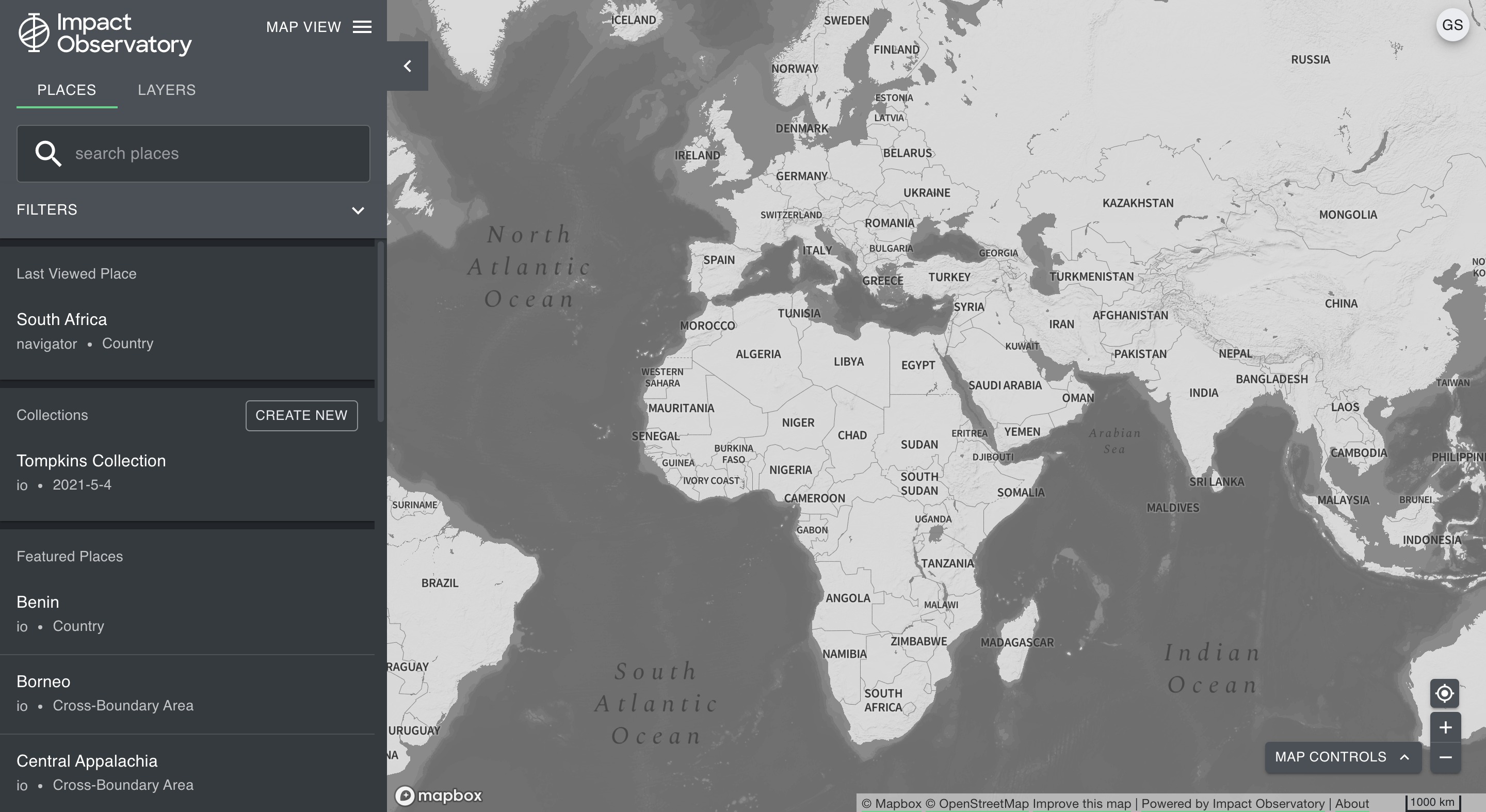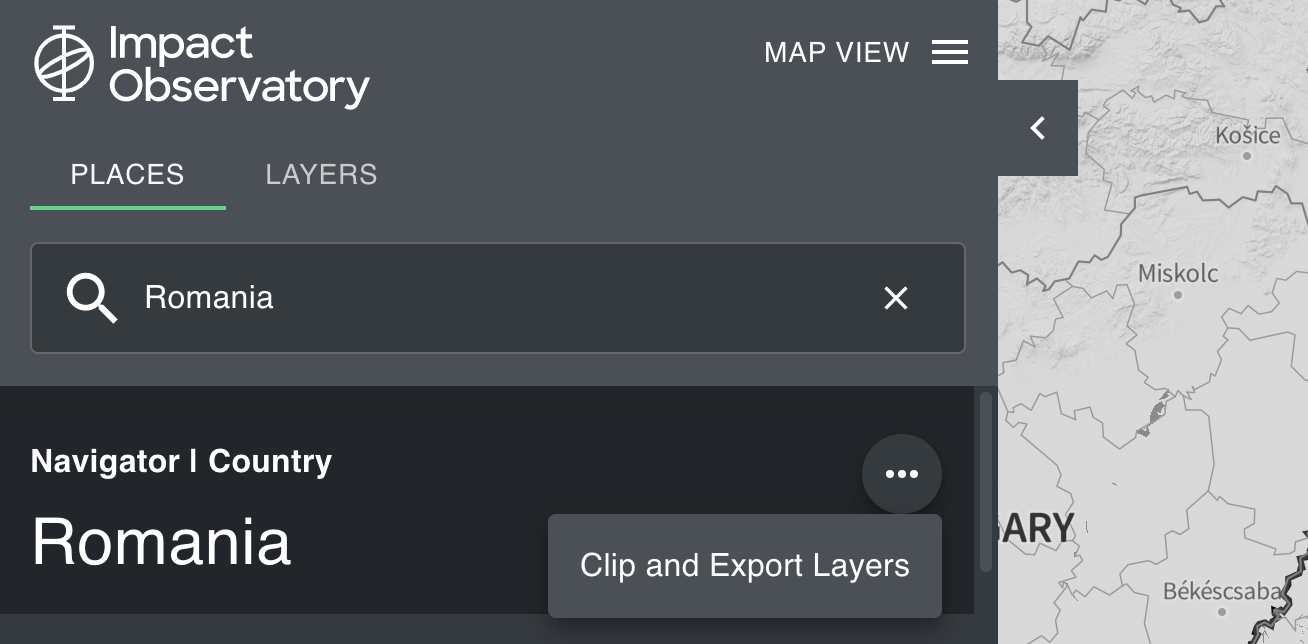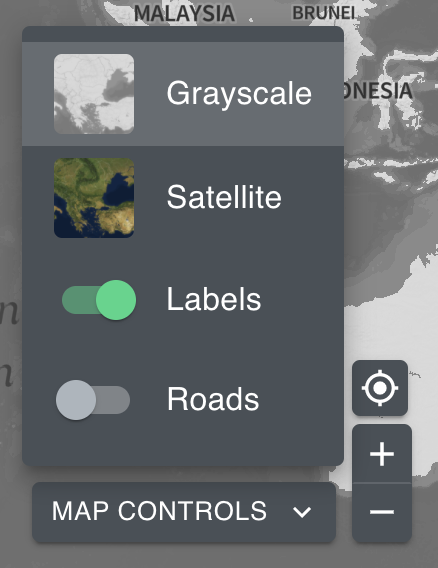The Map View
Upon launching the platform, you are brought to the map view. The map view is where you can search for places or layers to extract insights from Navigator’s catalog of environmental data and indicators.

Places Tab on Navigator
Early users have access to a catalog of places within the Navigator workspace. Navigator contains over 4,900 places representing all recognized countries and regions to measure and monitor environmental trends in any region of the world.
Search for a Place
Type in the name of a country or region while in the PLACES tab. Note that only the places within your selected workspaces will appear in the search results. Select the specific workspaces from the Map View button that you would like to search through.
You can also search within the PLACES tab using the filters box. Expand the Filters button, and select your filter of interest. You then can select the desired place from the search result list.
Click on a location from the search results to zoom the map into the area of interest and calculate the standard set of environmental indicators.
Where did Impact Observatory Source the Place files on Navigator from?
All shapes are from Who’s On First, a shape gazetteer that compiles a variety of open data sources to create a complete global set of country and region shapes.
Tip
Visit Who’s On First to find and download a free GeoJSON for nearly any place on Earth. Upload a GeoJSON to your private workspace on Navigator to calculate custom metrics over your area of interest. See *Create a Place* to learn how.
Your Places
Within your private workspace, you can upload custom places that are of interest to you and your organization. The standard set of indicators are calculated for any places uploaded to your private workspace.
Once a place in your private workspace is published, it will appear in the search results of the places tab for all users in your organization. If you are not seeing your places in the search results, you may need to select your workspace from the drop down menu from the MAP VIEW button. If you have no workspaces selected, the search applies to all workspaces.
Layers Tab on Navigator
All users have access to a standard catalog of global environmental datasets, referred to as layers, to monitor and track environmental trends anywhere in the world. The set of global layers are located within the Navigator workspace. Additional layers can be added to your private workspace.
Search for a layer
From the LAYERS tab, type in the name or part of a name of a dataset. Note that only layers within your selected workspaces will appear in the search results. Select the specific workspaces from the Map View button that you would like to search through. You can also use the FILTERS button to filter the search results by a dataset’s associated category.
Layer Controls
Toggle on a layer to view it on the map.
Each layer legend contains additional controls to edit the layer transparency, hide the layer, read a description of the layer and source information, and remove the layer from the map.
Users may add multiple layers to the map simultaneously and alter the order they appear in using the leftmost dots icon in the legend. Try changing the transparency of one layer to see how information from two layers overlaps.

About Layers on Navigator
Additional information is available by clicking on the “i” button in a layer’s legend including:
The information in this description box can be edited by users with editor, admin, or owner permissions.
Download the Data from an Original Source
If data is available for download from an original source you can find a link to the original source in the description box.
To find the link for a certain layer:
If a Download the Data hyperlink is not listed, the layer is not available for download from an outside source.
Clip and Export Data
You can use the clip and export layer button to download data for a specific place for use in a slide deck, report, or document:

Select the PLACES tab in the left-hand panel, search for and select your desired place.
Click on the “More Options” button next to the title of the place to open the “Click and Export Layer” drop down.
A new tab will open in the left-hand panel. Search for and select your layer of interest. If your layer contains reference layers, such as multiple years or multiple versions of the data, you will need to select one of the reference layers from a second drop down menu.
Select the download format. Currently, the platform only supports PNG format.
Click DOWNLOAD to clip and export the layer for only the selected place. The PNG image will save to the Downloads folder on your local computer. Some layers are not available for download due to license restrictions.
Map Controls
The MAP CONTROLS button in the bottom right corner of the map allows you to edit the basemap, zoom in or out, turn on or off labels and roads, and recenter the map over the selected place. The satellite basemap, labels, and roads are provided by Mapbox.

Basemaps
The basemap can be set to a grayscale map style or a satellite basemap from Mapbox. No specific dates for imagery can be provided by Mapbox at this time. Satellite basemap images are from a variety of satellites and range from a few years to a few months old. Because there is no way to determine the date the images on the satellite basemap were taken, it should not be used exclusively to verify results, rather only as a general reference.



